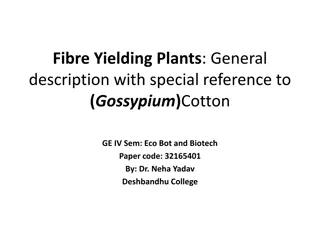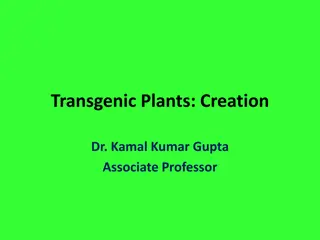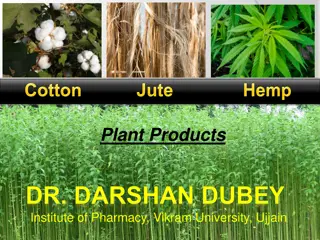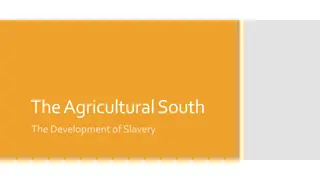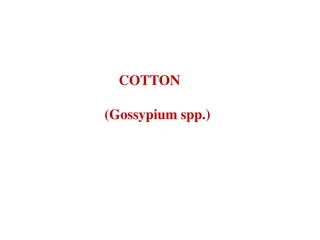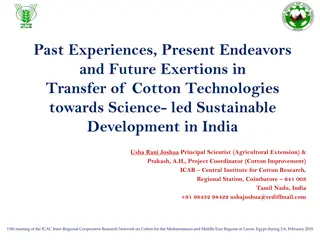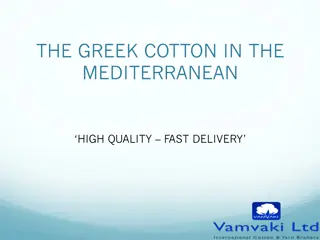Transgenic Cotton: Gateway to Sustainable Cotton Production in India
This content discusses the impact of transgenic cotton on sustainable cotton production in India over the past five decades, highlighting key milestones in Indian agriculture and the increase in productivity and production of cotton. It also compares the yield of Bt vs. non-Bt hybrids and provides insights into the economics of cotton cultivation. The data presented sheds light on the evolution of cotton farming practices and the role of genetic modifications in enhancing crop yields.
Download Presentation

Please find below an Image/Link to download the presentation.
The content on the website is provided AS IS for your information and personal use only. It may not be sold, licensed, or shared on other websites without obtaining consent from the author.If you encounter any issues during the download, it is possible that the publisher has removed the file from their server.
You are allowed to download the files provided on this website for personal or commercial use, subject to the condition that they are used lawfully. All files are the property of their respective owners.
The content on the website is provided AS IS for your information and personal use only. It may not be sold, licensed, or shared on other websites without obtaining consent from the author.
E N D
Presentation Transcript
Transgenic Cotton : Gateway to Sustainable Cotton Production- Experience India V.Kumar Former Research Scientist (Cotton) Main Cotton Research Station, NAU Surat, India ICAC 13th Meeting of IRCR Network on Cotton 2-6 February 2018, Luxor, Egypt Views/interpretations expressed by the presenter may/may not be subscribed by the affiliating institute
The Three Milestones of Indian Agriculture Introduction of Norin 10-Brevor 14 dwarfing gene in wheat which led to green revolution in the mid 60s. Release of first commercially successful hybrid cotton Hybrid-4 in early 70s which led to white revolution. Release of first GM crop i.e., Bt cotton in the beginning of current century leading to gene revolution?
Cotton in last five decades in India Productivity Production CAGR CAGR Av. Produc tivity (Kg/ha) Average increase in Yield (Kg/ha /year) Av. Average increase in production (lakh bales /year) Year Production (lakh bales) 1960- 61 to 70-71 Pre Hybrid era 117 51.27 1971- 72 to 01-02 Post Hybrid era 214 3.24 1.97 101.33 1.67 2.22 2002- 03 to 11-12 Post Hybrid + Bt era 473 267.95 28.77 8.25 18.51 10.21
Average area, production & productivity of cotton in India
Increase in average productivity & CAGR of lint in India (over previous FYP) 30 27.8 25 20 15.8 15 10 7.94 6.3 5 3.37 1.21 0 2002-07 2007-12 2012-15 CAGR Productivity (Kg/ha/yr)
Increase in average production & CAGR of lint in India (over previous FYP)
Seed cotton yield (kg/ ha) of Bt Vs non-Bt hybrids Hybrid 2008-09 2009-10 2010-11 Pooled RCH-2 (BG-II) 4088 3183 2744 3338 RCH-2 (Non Bt) 2651 1999 1524 2058 CD @ 5 % 668 426 371 161 CV (%) 13.8 11.4 11.6 12.9
Economics of cotton cultivation (Rs/ha) Operations/Inputs BT Non Bt A. Cultural operations 26100 26100 B Labour Plant protection 1350 2700 Picking 13360 8240 Total (B) 14710 10940 C. Input cost Seed 2790 1350 Insecticide 2300 5900 Total (C) 5090 7250 Total cost (Rs/ha) ( A+B+C) 45900 3338 44290 2058 Production (Kg/ha) Gross income(Rs/ha) 150210 92610 Net profit (Rs/ha) 104310 48320 Based on three years average yield
Import & export of cotton in India 140 120 100 80 60 40 20 0 Import (Lakh bales) Export (Lakh bales)
Average usage of insecticides per year in cotton in India (metric tonnes) Period Sucking pests Bollworms Total Insecticide kg/ha 1997-02 3798.6 (32.3) 7696.4 (65.5) 11750.4 [33.4] 1.328 2002-07 2563.2 (34.8) 4464.0 (60.6) 7362.4 [23.3] 0.878 2007-12 5428.0 (84.7) 564.8 (8.8) 6708.4 [18.9] 0.611 ( ) figures indicate per cent of total insecticides used in cotton [ ] figures indicate percent insecticides in cotton of the total used in India
Estimated nutrient mining (kg/ha)* by cotton in Gujarat F Y P N P2O5 K2O IX (375) 57.38 11.21 78.75 X (580) 88.74 17.34 121.80 XI (674) 103.12 20.15 141.54 *based on average lint productivity kg/ha()
Green house gas (GHG) emission from pesticide application in cotton Year Non Bt Cotton Bt Cotton No. of sprays Emission due to pesticide No. of sprays Emission due to pesticide kgCO2e/ha kgCO2e/t kgCO2e/ha kgCO2e/t 2008-09 11 1973 744 5 888 198 2009-10 8 1460 730 4 717 225 2010-11 8 1471 965 5 905 330 Average Reduct. (%) 9 1635 794 4.7 837 (-48.8) 251 (-68.4) (-47.8) * The data may/may not represent absolute values
Environment impact quotient (EIQ) field rating Year Non Bt Cotton Bt Cotton % Reduction 2008-09 92.18 20.38 77.9 2009-10 55.63 20.94 62.4 2010-11 47.93 31.44 34.4 Average 65.25 24.25 58.2 EIQ Field Rating= EIQ x % a.i. x Rate * The data may/may not represent absolute values
Fertilizer N use efficiency (kg/kg N) of Bt Vs non-Bt hybrids Hybrid 2008-09 2009-10 2010-11 Average RCH-2 (BG-II) 17.0 13.3 11.4 13.9 RCH-2 (Non Bt) 11.0 8.3 6.4 8.6 Addl. Seed cotton yield per unit N in Bt (%) 6.0 (54.5) 5.0 (60.2) 5.0 (78.1) 5.3 (61.6) Fertilizer NPK @ 240 : 0 : 0 kg/ha
Irrigation water use efficiency (kg/ha.mm of water) of Bt Vs non-Bt hybrid Hybrid 2008-09 2009-10 2010-11 Average RCH-2 (BG-II) 29.2 22.7 39.2 30.4 RCH-2 (Non Bt) 18.9 14.3 21.8 18.3 Addl. Seed cotton yield per unit water in Bt (%) 10.3 (54.5) 8.4 (58.7) 7.4 (33.9) 8.7 (47.5) Irrigation : 2008-09 and 2009-10 2010-11 140 mm 70 mm
Energy use estimates for US cotton production Bt cotton produces more energy than it uses in its production vis-a-vis conventional cotton Source: Cotton Incorporated, 2009
Green house gas emissions from US cotton production Bt cotton stores more CO2 than it emits in its production vis-a-vis conventional cotton Source: Cotton Incorporated, 2009
On the social front, Bt cotton fulfilled the third dimension of sustainability fully well and positively. Upto 95 % area covered under Bt cotton and near 50 % increase in total cotton area in India is the best testimony that the technology was well received by the society. Higher returns and disposable income, lesser exposure to pesticides ensured better health and nutrition to the farmers. To conclude India has immensely benefitted from Bt transgenic technology in terms of economic gains to all stake holders, better and safer environment, social upliftment and therefore, sustainable cotton production. Recently some issues said to be associated with Bt cotton have emerged. No technology is risk free, especially if it is over exploited and injudiciously implemented.








